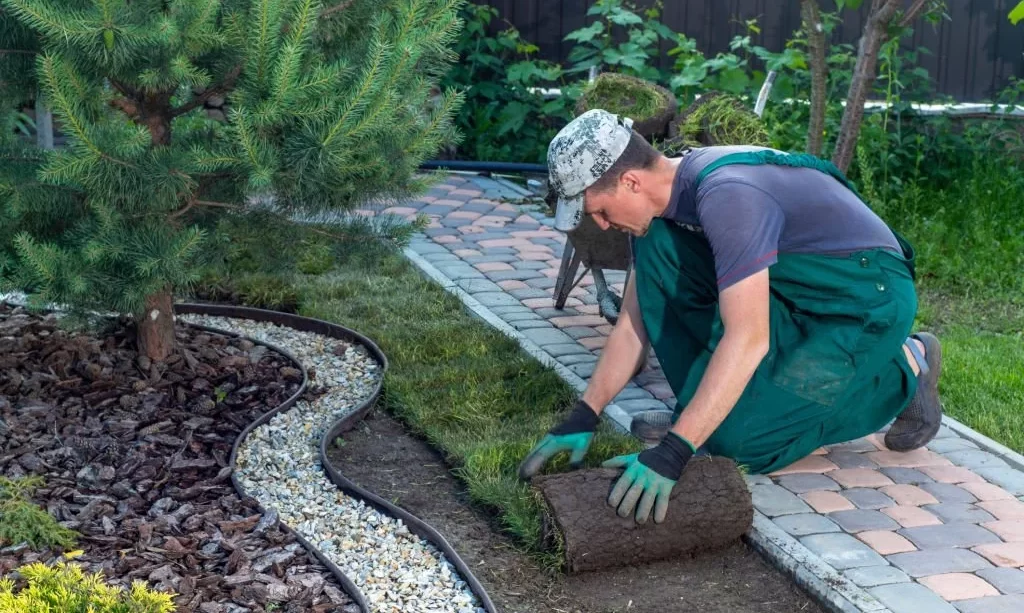Landscaping is a profession deeply intertwined with the seasons, and each season brings unique challenges and opportunities. As the vibrant colors of autumn fade and the first snowflakes fall, landscapers face the transition into the winter months. While the colder season may seem like a period of dormancy for outdoor spaces, professional landscapers remain active, finding purposeful ways to contribute to the beauty and functionality of properties even during winter’s chill. In this article, we’ll explore what landscapers do in the winter, from planning and design work to the practical aspects of snow removal and maintenance. We’ll begin by delving into the world of winter planning and design.
Winter Planning and Design
The winter season provides an ideal backdrop for planning and design work in the landscaping industry. Here’s a closer look at how landscapers make the most of this time:
- Client Collaboration: During the winter, landscapers often engage in consultations and collaborations with clients. This is a prime opportunity for clients to share their ideas and preferences for spring and summer landscaping projects.
- Project Development: Landscapers use the winter months to develop detailed project plans. These plans include layout designs, plant selections, hardscape features, and budget estimates. This meticulous planning sets the stage for seamless execution when warmer weather arrives.
- Plant Selection: Winter is a time for landscapers to research and select the plant varieties that will thrive in the coming seasons. They consider factors like soil type, sun exposure, and climate suitability to ensure the health and longevity of the chosen plants.
- Design Refinements: Landscapers refine landscape designs based on client feedback and considerations for seasonal changes. Winter’s bare landscapes allow for a clear canvas on which to envision future transformations.
- Winter-Friendly Landscaping: Part of the planning process involves incorporating winter-friendly landscaping elements. Landscapers may suggest features like evergreen trees and shrubs, which maintain their foliage throughout the winter, adding beauty and structure to the landscape.
- Permitting and Regulations: Landscapers use the winter months to navigate the permitting and regulatory requirements for upcoming projects. This ensures that all necessary approvals are in place for a smooth project timeline.
- Education and Training: Some landscapers take advantage of the offseason to pursue further education and training. Workshops and courses can expand their knowledge of the latest landscaping trends, sustainable practices, and emerging technologies.
Winter planning and design lay the foundation for a successful landscaping season ahead. By collaborating with clients, refining designs, and preparing for projects, landscapers ensure that they are ready to bring outdoor spaces to life when spring arrives.
Snow Removal Services
Snow removal is a vital aspect of landscaping during the winter months, especially in regions prone to heavy snowfall. Landscapers provide a range of snow removal services to keep outdoor spaces safe and accessible. Here’s what this essential aspect of their winter work entails:
- Snow Plowing: Landscapers use snowplows to clear driveways, parking lots, and pathways. This heavy-duty equipment efficiently removes accumulated snow, making it easier for residents and businesses to navigate their properties.
- Shoveling and Salting: In addition to plowing, landscapers often engage in manual snow removal by shoveling walkways and applying salt or de-icing agents to prevent slippery surfaces. This meticulous work ensures safe passage for pedestrians.
- Roof Snow Removal: Heavy snow accumulation on roofs can pose structural risks. Landscapers may offer roof snow removal services to prevent potential damage and collapse.
- Emergency Response: Landscapers are ready for emergency snow removal, especially during severe winter storms. Timely response to extreme weather events is crucial for maintaining safety and accessibility.
- Parking Lot Maintenance: Commercial properties rely on landscapers to keep parking lots clear and safe. Well-maintained parking areas ensure that businesses can continue to operate smoothly during winter.
- Sidewalk Clearing: Landscapers clear snow and ice from sidewalks, ensuring that pedestrians can traverse city streets, business districts, and residential neighborhoods without obstruction.
- Snow Relocation: In some cases, landscapers relocate snow from one area to another, such as designated snow storage locations, to prevent excessive buildup and maintain aesthetic appeal.
Snow removal services are not only a practical necessity but also a critical safety measure during the winter season. Landscapers use their expertise and specialized equipment to mitigate the challenges presented by snow and ice, ensuring that both residential and commercial properties remain accessible and hazard-free.
Maintenance and Pruning
Landscaping doesn’t come to a halt in the winter; it transforms to focus on the unique needs of the season. Maintenance and pruning play essential roles during this time:
- Winter Pruning: Landscapers conduct winter pruning to maintain the health and shape of trees and shrubs. With leaves gone, it’s easier to identify dead or diseased branches and remove them. Pruning also promotes better air circulation and reduces the risk of fungal diseases.
- Tree Care: Landscapers provide specialized care for trees during the winter. This includes applying protective coatings to prevent winter sunscald and wrapping trunks to shield them from rodent damage.
- Plant Bed Cleanup: Landscapers clear plant beds of debris, fallen leaves, and dead vegetation. This helps prevent the growth of mold and pests while preparing the landscape for the coming spring.
- Mulching: Applying mulch to plant beds during the winter helps insulate the soil, maintaining a more stable temperature and moisture level. It also suppresses weed growth.
- Fertilization: In some cases, landscapers apply slow-release fertilizers to the soil to provide essential nutrients to plants during the dormant winter months.
- Equipment Maintenance: Landscapers ensure that their equipment, including pruning shears and chainsaws, is in good working order. Regular maintenance and sharpening of tools are essential for efficient winter pruning.
- Consultations and Planning: Landscapers use the winter season for client consultations and planning upcoming projects. This includes discussing design changes, selecting plant varieties, and setting budgets.
Maintenance and pruning are vital aspects of winter landscaping, allowing for the continued health and beauty of outdoor spaces even when the landscape is covered in snow. By tending to plants and trees during the dormant season, landscapers set the stage for a vibrant and thriving landscape when spring arrives.
Hardscaping and Construction
In the winter, landscapers often shift their focus to hardscaping and construction projects, taking advantage of the colder months to work on installations that are less affected by low temperatures. Here’s a closer look at what this aspect of their work entails:
- Patio Construction: Landscapers design and build outdoor patios, creating functional and aesthetically pleasing spaces for homeowners to enjoy during the warmer months. Winter provides an ideal timeframe to lay the foundation and install hardscape materials like pavers.
- Retaining Walls: The construction of retaining walls is another winter-friendly project. These structures serve both functional and decorative purposes, helping to control erosion and add dimension to the landscape.
- Outdoor Fireplaces and Fire Pits: Landscapers often design and build outdoor fireplaces and fire pits during the winter. These features provide warmth and a cozy ambiance for outdoor gatherings, making them popular additions to residential landscapes.
- Walkways and Pathways: Building walkways and pathways using materials like flagstone, concrete, or gravel is a winter-appropriate project. These paths enhance the functionality and accessibility of outdoor spaces.
- Water Features: While it might seem counterintuitive, winter is an excellent time to install water features like fountains and ponds. Proper construction and waterproofing ensure these features function flawlessly come spring.
- Deck Construction: For properties that include outdoor decks, winter can be a suitable time to construct or renovate them. Landscapers take advantage of the offseason to plan and execute deck projects.
Equipment Maintenance
Maintaining landscaping equipment is crucial to ensuring that it operates efficiently when needed. Here’s how landscapers manage equipment maintenance during the winter months:
- Inspections: Landscapers perform thorough inspections of their equipment to identify any signs of wear, damage, or malfunction. This includes checking engines, hydraulics, and safety features.
- Routine Servicing: Regular servicing of equipment is essential. Landscapers change oil, replace filters, and lubricate moving parts to keep everything in top working condition.
- Sharpening Tools: Landscaping tools like mower blades, chainsaw chains, and pruning shears require sharpening to maintain their effectiveness. Dull tools can damage plants and slow down work.
- Winterization: To protect equipment from freezing temperatures, landscapers winterize their machines. This involves draining fluids, adding antifreeze, and storing equipment in sheltered areas.
- Irrigation System Care: If the property has an irrigation system, winterization is vital to prevent frozen pipes and damage. Landscapers ensure that irrigation systems are properly drained and shut off for the season.
Equipment maintenance not only prolongs the lifespan of landscaping tools but also ensures that they are ready for use as soon as the weather allows for outdoor work. By taking care of their equipment during the winter, landscapers can hit the ground running when spring arrives and projects resume.
Continuing Education and Training
For professional landscapers, the winter season offers an opportunity for personal and professional growth through education and training. Here’s how they make the most of this time:
- Workshops and Seminars: Landscapers attend workshops and seminars related to landscaping trends, sustainability practices, and emerging technologies. These events provide valuable insights and keep them updated on industry developments.
- Certification Programs: Some landscapers pursue certification programs during the winter months to enhance their skills and qualifications. Certifications may cover topics like landscape design, plant care, or irrigation systems.
- Professional Associations: Landscapers actively participate in professional associations and organizations. These groups offer networking opportunities, access to educational resources, and industry-specific publications to help landscapers stay informed.
- License Renewal: Maintaining professional licenses is a priority. Landscapers use the winter to ensure that their licenses are up to date, fulfilling any required continuing education credits.
- Equipment Training: If landscapers invest in new equipment or technologies, they use the offseason for training and familiarization. This ensures that they can operate the latest tools efficiently and safely.
- Environmental Stewardship: The winter season provides a chance to explore environmentally friendly practices and sustainability initiatives. Landscapers may seek training in eco-friendly landscaping techniques and materials.
Administrative Tasks and Client Communication
Behind the scenes, landscapers engage in various administrative tasks and maintain open lines of communication with clients during the winter months:
- Accounting and Budgeting: Landscapers manage their finances, reviewing budgets, and conducting accounting tasks. This includes invoicing, payroll, and tracking expenses.
- Marketing and Promotion: Winter is an excellent time to focus on marketing efforts. Landscapers update their websites, create marketing materials, and plan advertising campaigns to attract new clients.
- Client Consultations: Landscapers continue to meet with clients, discussing upcoming projects and addressing any concerns or questions. Winter consultations allow clients to plan for spring and summer landscaping projects.
- Winter Landscaping Tips: Landscapers may provide clients with tips for maintaining their landscapes during the winter. This includes guidance on protecting plants, dealing with snow, and planning for future improvements.
- Proposal and Contract Preparation: Landscapers work on proposals and contracts for upcoming projects. They ensure that all project details are well-defined and meet client expectations.
- Feedback and Reviews: Landscapers value client feedback and may request reviews from past clients. Positive reviews and testimonials strengthen their reputation and credibility.
Landscapers recognize that successful landscaping projects involve more than just the physical labor of creating beautiful outdoor spaces. Behind the scenes, they invest time and effort into continuous learning, business operations, and maintaining strong client relationships, all of which contribute to their success in the industry.
Rest and Recovery
While the winter months are filled with planning, maintenance, and training for landscapers, it’s also a crucial time for rest and recovery. Here’s why this aspect of their offseason is essential:
- Physical and Mental Regeneration: Landscaping is physically demanding, and the constant exposure to outdoor elements can be exhausting. Winter provides landscapers with an opportunity to recover from the physical toll of their work and reduce the risk of burnout.
- Mental Refreshment: The quieter winter season allows landscapers to mentally refresh and recharge. It’s a time to reflect on the past year’s projects, set goals for the coming season, and find inspiration for new designs.
- Family Time: Landscapers often work long hours during the growing season, which can limit their time with family and friends. Winter offers a chance to spend quality time with loved ones and nurture those relationships.
- Health and Well-being: Landscapers may use the offseason to focus on their health and well-being. This can include exercise, healthy eating, and doctor visits to address any physical concerns.
- Hobbies and Interests: Many landscapers have hobbies and interests outside of their profession. Winter is an excellent time to indulge in these pursuits, whether it’s a passion for gardening, painting, or other creative endeavors.
- Personal Development: Landscapers may engage in personal development activities, such as reading, learning new skills, or pursuing hobbies that enrich their lives.
Taking time for rest and recovery ensures that landscapers return to their work in the spring with renewed energy, creativity, and enthusiasm. It’s a vital part of maintaining a sustainable and fulfilling career in landscaping.
Conclusion
In conclusion, the world of landscaping doesn’t come to a halt when winter arrives. Landscapers adapt to the season, finding purposeful ways to contribute to the beauty and functionality of outdoor spaces, even in the face of cold and snow.
From winter planning and design to snow removal services, maintenance, and construction, landscapers wear multiple hats to ensure that landscapes are well-prepared for the upcoming spring and summer. They invest in continuing education, handle administrative tasks, and maintain strong client relationships. They also prioritize rest and recovery to recharge physically and mentally.
The landscaping profession is a year-round commitment, with each season offering its own set of challenges and opportunities. Landscapers are not just caretakers of outdoor spaces; they are dedicated professionals who work tirelessly to transform landscapes into havens of beauty and functionality, regardless of the season. As winter turns to spring, they emerge from the offseason fully prepared to bring their clients’ outdoor visions to life once more.



